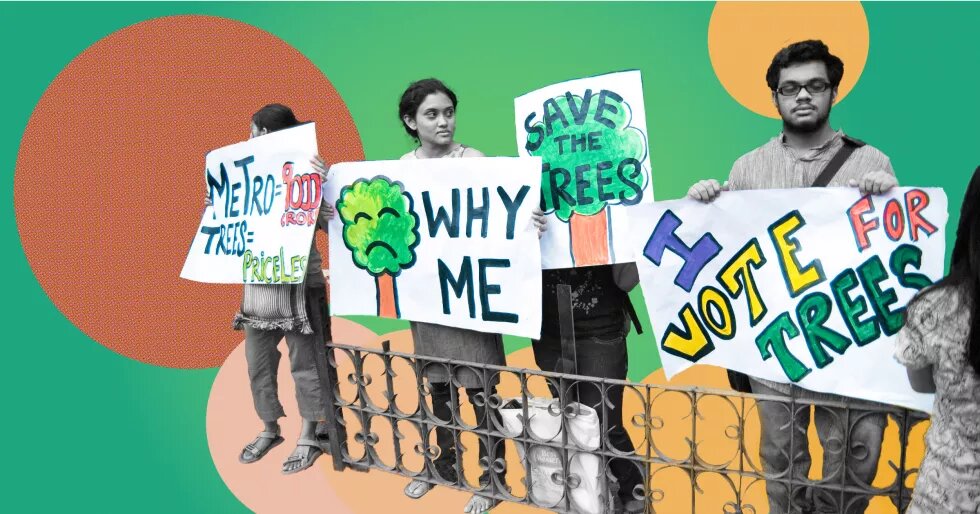Electoral politics is driven by demands not needs, and voters can push for inclusion of environmental concerns on the agenda of political parties.

India has witnessed several environmental movements over the last 50 years. For example, in the 1970s, spearheaded by rural women, the Chipko (tree-hugging) movement opposed commercial logging and deforestation in the Himalayas. In the 1980s-90s, the Narmada Bachao Andolan, a mass movement by tribals and environmentalists against constructing large dams on the Narmada river, shook up the nation. Such resistances continue in 21st-century India. Some are against the eviction of people from Tiger Reserves, while others are to prevent lands and forests from being converted into industrial complexes and for mega infrastructural projects. Although these resistances have been at times highly visible responses to the aggressive model of progress emerging from the nexus of the state and large corporates and although they play an important role in highlighting people’s dire need for a healthy environment, they never transcended to shape India’s political discourse in significant ways. But why is that the case?
Firstly, post-material societies embrace environmental issues in politics far more than societies struggling to meet their daily needs. A society that has fulfilled its political priorities of economic growth and wealth redistribution is better positioned to address environmental concerns more effectively. In a situation where a country’s collective social and economic foundation is still weak, voters may not support environmental policies or have environmental issues as their priority.
The environmental discourse in India therefore needs to distinguish between the benefits people gain from protecting the planetary well-being, which is for a ‘greater larger good’, and individual benefits focused on the well-being of the person or their family, if the environment was protected. Electoral issues such as employment are seen as tangible, direct, feasible, immediate, and relatable. Therefore, voters are influenced by electoral promises that target individuals, families, and communities. Environmental challenges such as climate change all too often appear vague or disconnected from daily struggles. Societies fighting to fulfil their everyday needs expect the political parties to be an immediate return system, not a delayed return system. A typical voter in India would look for a return that will be quick, tangible, direct and personal, rather than voting for environmental issues that may take some time to show results.
However, even though one cannot see a strong environmental debate in the election campaigns at the national level, political parties have time and again campaigned around issues of, for example, clean water or land rights. Yet, such campaigns usually cater for a specific constituency such as the rural poor or tribals at a regional and local level. And where this happens, these issues are not framed as environmental issues but rather as social or welfare issues to alleviate poverty.
Secondly, the notion of the environment is often thought of as something devoid of the ‘social’ or the ‘political’, even though the link between, say, the environment and public health is profoundly social and political. Environmental degradation harms the health of humans and other beings, social cohesion, and economic, political and cultural well-being. While people’s health gets affected due to environmental deterioration, their concerns do not become a political issue. According to Yogendra Yadav, one of India’s leading political scientists and founder of a political party:
“Air pollution or climate change will not become a political issue by itself, no matter how acute the problem. It has to be made into an issue”
Yadav, Y. 2021 https://theprint.in/opinion/smog-of-democracy-why-air-pollution-is-not-…
Yadav therefore proposes collective action to make it a decisive electoral issue and adds that competitive politics responds to demands, and not just needs. Unless voters demand and speak on environmental issues, they will not become an election issue.
Thirdly, environmental issues have varying degrees of impact on communities. Privileged groups with sufficient support systems generally cope better during severe environmental crises than those not well off. Especially in India, the social hierarchies are even more stark, with clear caste-based division of haves and have-nots. The burden of environmental deterioration is mainly faced by the underprivileged communities, such as the landless, Dalits (‘untouchables’) or Adivasis (tribals). Such communities for a lack of resources to, for example, protect themselves from polluted air, pay a higher price in a degraded environment. Unless the environmental problems become a critical and urgent issue for most voters, including the resourceful middle class, the parties will be reluctant to make environmental issues a priority in their political agenda.
As India gears up for the next election, one can only hope that sections of the public push their agenda on environmental concerns to make them matter in India’s political discourse beyond their mere mentioning in political party manifestos. The fact that the All India Survey on Governance Issues and Voting Behaviour found that the top voter priority of employment is followed by issues such as clean drinking water and air pollution gives some hope.
Disclaimer:
This article was prepared with the support of the Heinrich Böll Stiftung. The views and analysis contained in the publication are those of the author and do not necessarily represent the views of the foundation. Heinrich Böll Stiftung will be excluded from any liability claims against copyright breaches, graphics, photographs/images, sound document and texts used in this publication. The author is solely responsible for the correctness, completeness and for the quality of information provided.


